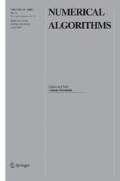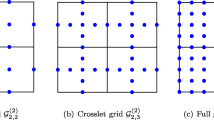Abstract
We present new and review existing algorithms for the numerical integration of multivariate functions defined over d-dimensional cubes using several variants of the sparse grid method first introduced by Smolyak [49]. In this approach, multivariate quadrature formulas are constructed using combinations of tensor products of suitable one-dimensional formulas. The computing cost is almost independent of the dimension of the problem if the function under consideration has bounded mixed derivatives. We suggest the usage of extended Gauss (Patterson) quadrature formulas as the one‐dimensional basis of the construction and show their superiority in comparison to previously used sparse grid approaches based on the trapezoidal, Clenshaw–Curtis and Gauss rules in several numerical experiments and applications. For the computation of path integrals further improvements can be obtained by combining generalized Smolyak quadrature with the Brownian bridge construction.
Similar content being viewed by others
References
A.R. Barron, Approximation and estimation bounds for artificial neural networks, Machine Learning 14 (1994) 115–133.
G. Baszenski and F.-J. Delvos, Multivariate Boolean midpoint rules, in: Numerical Integration IV, eds. H. Brass and G. Hämmerlin (Birkhäuser, Basel, 1993) pp. 1–11.
T. Bonk, A new algorithm for multi-dimensional adaptive numerical quadrature, in: Adaptive Methods – Algorithms, Theory and Applications, eds. W. Hackbusch and G. Wittum (Vieweg, Braunschweig, 1994) pp. 54–68.
H. Brass and K.-J. Förster, On the estimation of linear functionals, Analysis 7 (1987) 237–258.
H.-J. Bungartz, Dünne Gitter und deren Anwendung bei der adaptiven Lösung der dreidimensionalen Poisson-Gleichung, Dissertation, Institut für Informatik, Technische Universität München (1992).
R.E. Caflisch, W.J. Morokoff and A. Owen, Valuation of mortgage backed securities using Brownian bridges to reduce effective dimension, J. Comput. Finance 1 (1997).
C.W. Clenshaw and A.R. Curtis, A method for numerical integration on an automatic computer, Numer. Math. 2 (1960) 197–205.
R. Cools and B. Maerten, Experiments with Smolyak’s algorithm for integration over a hypercube, Internal Report, Department of Computer Science, Katholieke Universiteit Leuven (1997).
P.J. Davis and P. Rabinowitz, Methods of Numerical Integration (Academic Press, New York, 1975).
F.-J. Delvos, d-variate Boolean interpolation, J. Approx. Theory 34 (1982) 99–114.
F.-J. Delvos and W. Schempp, Boolean Methods in Interpolation and Approximation, Pitman Research Notes in Mathematics Series, Vol. 230 (Longman, Essex, 1989).
M.G. Duffy, Quadrature over a pyramid or cube of integrands with a singularity at a vertex, SIAM J. Numer. Anal. 19 (1982) 1260–1262.
S. Elhay and J. Kautsky, A method for computing quadratures of the Kronrod–Patterson type, Austral. Comput. Sci. Comm. 6(1) (1984) 15.1–15.8.
S. Elhay and J. Kautsky, Generalized Kronrod–Patterson-type imbedded quadratures, Appl. Math. 37(2) (1992) 81–103.
K. Frank and S. Heinrich, Computing discrepancies of Smolyak quadrature rules, J. Complexity 12 (1996).
J. Garcke, Berechnung der kleinsten Eigenwerte der stationären Schroedingergleichung mit der Kombinationstechnik, Master’s thesis, Institut für Angewandte Mathematik, Universität Bonn (1998), to appear.
A. Genz, A package for testing multiple integration subroutines, in: Numerical Integration, eds. P. Keast and G. Fairweather (Kluwer Academic Publishers, Dordrecht, 1987) pp. 337–340.
A. Genz and A.A. Malik, An adaptive algorithm for numerical integration over an n-dimensional rectangular region, J. Comput. Appl. Math. 6 (1980) 295–302.
T. Gerstner, Adaptive hierarchical methods for landscape representation and analysis, in: Proc. of the Workshop on Process Modelling and Landform Evolution, eds. S. Hergarten and H. Neugebauer (Springer, Berlin, 1998).
G.H. Golub and J. Kautsky, Calculation of Gauss quadratures with multiple free and fixed knots, Numer. Math. 41 (1983) 147–163.
W.J. Gordon, Blending function methods of bivariate and multivariate interpolation and approximation, SIAM J. Numer. Anal. 8 (1971) 158–177.
M. Griebel, A parallelizable and vectorizable multi-level algorithm on sparse grids, in: Parallel Algorithms for Partial Differential Equations, ed. W. Hackbusch, Notes on Numerical Fluid Mechanics, Vol. 31 (Vieweg, Braunschweig, 1991).
M. Griebel, The combination technique for the sparse grid solution of PDEs on multiprocessor machines, Parallel Process. Lett. 2(1) (1992) 61–70.
M. Griebel, P. Oswald and T. Schiekofer, Sparse grids for boundary integral equations, Numer. Math. (1998), to appear.
M. Griebel, M. Schneider and C. Zenger, A combination technique for the solution of sparse grid problems, in: Iterative Methods in Linear Algebra, eds. R. Bequwens and P. de Groen (Elsevier, North-Holland, 1992) pp. 263–281.
M. Griebel and G. Zumbusch, Adaptive sparse grids for hyperbolic conservation laws, in: Proc. of the 7th Internat. Conf. on Hyperbolic Problems (Birkhäuser, Basel, 1998).
K. Hallatschek, Fouriertransformation auf dünnen Gittern mit hierarchischen Basen, Numer. Math. 63 (1992) 83–97.
N. Heuer, M. Maischak and E.P. Stephan, The hp-version of the boundary element method for screen problems, Numer. Math. (1998), submitted.
M. Kac, On some connections between probability theory and differential and integral equations, in: Proc. of the 2nd Berkeley Symp. on Math. Stat. Prob., ed. J. Neyman (University of California Press, Berkley, 1951).
A.S. Kronrod, Nodes and Weights of Quadrature Formulas (Consultants Bureau, New York, 1965).
H.N. Mhaskar, Neural networks and approximation theory, Neural Networks 9 (1996) 711–722.
G. Monegato, Stieltjes polynomials and related quadrature rules, SIAM Rev. 24(2) (1982) 137–158.
W.J. Morokoff and R.E. Caflisch, Quasi-Monte Carlo integration, J. Comput. Phys. 122 (1995) 218–230.
H. Niederreiter, Random Number Generation and Quasi-Monte Carlo Methods (SIAM, Philadelphia, PA, 1992).
E. Novak and K. Ritter, Global optimization using hyperbolic cross points, in: State of the Art in Global Optimization, eds. C.A. Floudas and P.M. Pardalos (Kluwer Academic, Dordrecht, 1996) pp. 19–33.
E. Novak and K. Ritter, High dimensional integration of smooth functions over cubes, Numer. Math. 75 (1996) 79–97.
E. Novak and K. Ritter, The curse of dimension and a universal method for numerical integration, in: Multivariate Approximation and Splines, eds. G. Nürnberger, J.W. Schmidt and G. Walz (1997).
E. Novak and K. Ritter, Simple cubature formulas for d-dimensional integrals with high polynomial exactness and small error, Report, Institut für Mathematik, Universität Erlangen–Nürnberg (1997).
E. Novak, K. Ritter and A. Steinbauer, A multiscale method for the evaluation of Wiener integrals, J. Approx. Theory (1998), to appear.
S. Paskov, Average case complexity of multivariate integration for smooth functions, J. Complexity 9 (1993) 291–312.
S. Paskov and J.F. Traub, Faster valuation of financial derivatives, J. Portfolio Management 22 (1995) 113–120.
T.N.L. Patterson, The optimum addition of points to quadrature formulae, Math. Comp. 22 (1968) 847–856.
T.N.L. Patterson, Algorithm 672: Generation of interpolatory quadrature rules of the highest degree of precision with preassigned nodes for general weight functions, ACM Trans. Math. Software 15(2) (1989) 137–143.
T.N.L. Patterson, Modified optimal quadrature extensions, Numer. Math. 64 (1993) 511–520.
S.V. Pereverzev, An estimate of the complexity of the approximate solution of Fredholm equations of the second kind with differentiable kernels, Ukrainian Math. J. 141(2) (1989) 1225–1227.
R. Piessens and M. Branders, A note on the optimum addition of abscissas to quadrature formulas of Gauss and Lobatto type, Math. Comp. 28 (1974) 135–140, 344–347.
I. Robinson and A. Begumisa, Suboptimal Kronrod extension formulae for numerical quadrature, Numer. Math. 58 (1991) 807–818.
I.H. Sloan and S. Joe, Lattice Methods for Multiple Integration (Oxford University Press, Oxford, 1994).
S.A. Smolyak, Quadrature and interpolation formulas for tensor products of certain classes of functions, Dokl. Akad. Nauk SSSR 4 (1963) 240–243.
F. Sprengel, Periodic interpolation and wavelets on sparse grids, Numer. Algorithms 17 (1998) 147–169.
V.N. Temlyakov, Approximation of Periodic Functions (Nova Science, New York, 1994).
J.F. Traub, G.W. Wasilkowski and H. Wózniakowski, Information-Based Complexity (Academic Press, New York, 1988).
P. Van Dooren and L. De Ridder, An adaptive algorithm for numerical integration over an n-dimensional cube, J. Comput. Appl. Math. 2 (1976) 207–217.
G. Wahba, Interpolating surfaces: High order convergence rates and their associated design with applications to X-ray image reconstruction, Report, Department of Statistics, University of Wisconsin, Madison (1978).
G.W. Wasilkowski and H. Wózniakowski, Explicit cost bounds of algorithms for multivariate tensor product problems, J. Complexity 11 (1995) 1–56.
C. Zenger, Sparse grids, in: Parallel Algorithms for Partial Differential Equations, ed. W. Hackbusch, Notes on Numerical Fluid Mechanics, Vol. 31 (Vieweg, Braunschweig, 1991).
Rights and permissions
About this article
Cite this article
Gerstner, T., Griebel, M. Numerical integration using sparse grids. Numerical Algorithms 18, 209–232 (1998). https://doi.org/10.1023/A:1019129717644
Issue Date:
DOI: https://doi.org/10.1023/A:1019129717644




